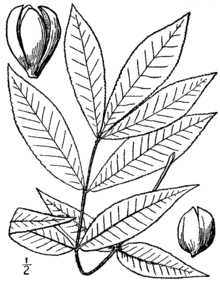Carya texana
| Black hickory | |
|---|---|
 | |
| 1913 illustration[1] | |
| Scientific classification | |
| Kingdom: | Plantae |
| Clade: | Angiosperms |
| Clade: | Eudicots |
| Clade: | Rosids |
| Order: | Fagales |
| Family: | Juglandaceae |
| Genus: | Carya |
| Section: | Carya sect. Carya |
| Species: | C. texana |
| Binomial name | |
| Carya texana Buckley (1861) | |
 | |
| Natural range of Carya texana | |
| Synonyms[2] | |
|
List
| |
Carya texana, the black hickory, is a North American tree in the walnut family. It is endemic to the United States, found primarily in the southern Great Plains and the Lower Mississippi Valley.[3][4]
Carya texana is an endangered species in southwestern Indiana.[3]
Carya texana is a tree growing to 41 metres (135 ft) in height. The leaves usually have a dense coating of scales, imparting rusty brown color. They are pinnately compound usually with 7 leaflets but sometimes 5 or 9. The fruits (nuts) are bronze to reddish brown, the seeds sweet and edible.[5]
Genetics
Black hickory is a 64 chromosome species that readily hybridizes with tetraploid C. tomentosa.[6] Hybrids with 32 chromosome species may also occur.
References
- ↑ Britton, N.L., and A. Brown. 1913. An illustrated flora of the northern United States, Canada and the British Possessions. 3 vols. Charles Scribner's Sons, New York. Vol. 1: 584.
- ↑ The Plant List, Carya texana Buckley
- 1 2 United States Department of Agriculture Plants Profile for Carya texana (black hickory)
- ↑ Biota of North America Program 2014 county distribution map
- ↑
- ↑ Grauke, L. J. "Black Hickory, C. Texana".
External links
- Photo of herbarium specimen at Missouri Botanical Garden, collected in Missouri in 1894
- Photo of mature fruit
| Wikimedia Commons has media related to Carya texana. |
This article is issued from
Wikipedia.
The text is licensed under Creative Commons - Attribution - Sharealike.
Additional terms may apply for the media files.